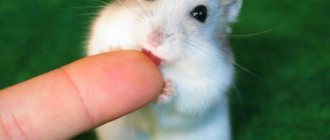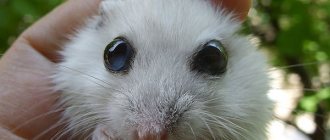Causes of a pet's aggressive behavior
Aggression in pets is observed after purchasing a rodent or in an adult animal. Finding the reasons why hamsters bite is the primary task of the rodent owner. The animal's bites are dangerous: its fangs are carriers of bacteria and pathogenic microflora. For animals, teeth are a “tool” through which they understand the world. The little hamster explores the new territory and bites anyone who picks him up.
New hamsters bite to get information. Rodents are guided by three senses: hearing, smell and taste. There is nothing threatening in the aggressiveness of a new pet; if the animal has a calm disposition and begins to bite, the owner should consider the possible reasons for the change in the pet’s mood: in the external environment and in the pet’s well-being (the pet is sick). If the hamster did not bite and suddenly became aggressive, the reasons why the hamster bites, in most cases, lie in the behavior of the owner: the pet feels a constant threat.
Misbehavior of the owner
If a rodent bites occasionally, it doesn't like its environment. The rodent will not go to hands that smell bad. Rodents perceive foreign odors ten times more strongly. A pet bites when it smells food or new treats. Dzungarika tries to find out the source of the new smell and bites the owner. This behavior is not the pet's fault. You should wash your hands before handling furry pets.
The second reason for a pet’s aggressiveness is abuse. The rule that works with rodents is “carefully handle your pet and no one will get hurt.” You shouldn’t get a sleeping pet out, and children can only be trusted with a calm animal. Feeling a threat, the individual tries to free itself and instinctively bites. Accustoming a pregnant female to handling is dangerous. The expectant mother protects her offspring with teeth and claws. A pregnant Dzungarika hides in the corners of the cage and does not go to the hands of the owner until the birth of the offspring.
Environmental conditions
A sharp sound or noise scares your furry pet. If your pet suddenly becomes aggressive, runs around the cage and does not go to your hands, the rodent shows stress. The furry pet is kept in a warm room away from household noise. It is better not to place the cage in the kitchen. If the rodent calmly walks towards the hands, the owner should not make sudden movements or shout: such behavior will cause a response from the rodent.
Djungarians bite in unfavorable conditions: if the cage is dirty and the room is cold. Rodents have a hard time withstanding sudden changes in the environment, moving and constant noise. A frightened rodent will rush at everyone.
Poor pet health
Your pet is growing and teething are starting to itch and hurt. If Dzhungarik's cage does not have a special branch or roots, he will have to bite the owner's hands. At home, cages are created for growing rodents at no additional cost: a branch of a fruit tree or a dandelion root is brought to the growing pet. Hamsters grow up quickly, and soon the pet will wean itself from biting its owner.
The sick individual tries to hide: it hides in the corner of the cage and buries itself in the sawdust. It is not advisable to touch such a rodent. Sick hamsters can injure a finger, palm, wrist, and make deep wounds. During treatment, the pet remains in a cage and does not have contact with people.
Which breed smells less?
Those who want to have a cute rodent at home often ask whether Djungarian hamsters stink, and which breeds smell less. It has already been decided that healthy, calm animals do not emit any unpleasant odors. Their feces smell bad, and not immediately, but when they accumulate for several days in one place.
It is logical that a large animal will produce more of these feces than a small one. This is the simplest explanation why Syrian hamsters’ cages need to be cleaned more often than small dwarf hamsters.
The second reason is long fur. It accumulates more odors from contact with dirty filler. Despite the fact that all hamsters are incredibly clean, the long fluffy coat that some breeds sport, in particular the Syrians, is more difficult to keep in order than the short one.
We recommend reading an article about comparing a hamster with a guinea pig.
Everyone loves the cute and funny animals hamsters. The children are absolutely delighted with them. However, as the famous proverb states, you can’t do without a fly in the ointment. Hamsters can sometimes be biters. Moreover, they are so biting that many refuse to continue owning rodents precisely for this reason. Let's figure out what makes the cutest fluffies turn to aggression.
Our main mistake is that we think too well of hamsters. We attribute to them abilities and properties that they do not have and cannot have. Hamsters are not very smart, as we think. And their picture of the world is fundamentally different from ours. And that is why they show us behavioral patterns that seem strange to us, to put it mildly.
Incorrect identification. Hamsters have poor vision and rely primarily on their senses of smell and hearing. Conduct an experiment: bring a finger to the hamster that carries an attractive edible aroma. The hamster will almost certainly pull this finger on you. Not that it will bite. But as for the blood, that's obvious.
Unusual smell. Hamsters, as you might guess, detect the approach of their owners by a familiar smell. What if your smell is mixed with another, strong, but unidentified? The hamster will immediately switch to “defense” mode and, possibly, rush to attack.
Improper and rude treatment. Hamsters must be handled skillfully, with careful movements, and carefully. These animals do not tolerate rudeness and unceremoniousness. They can also “take revenge” - that is, bite. The goal is far-reaching: so that you fall behind quickly and for a long time.
Sharp awakening. We do not recommend pushing, disturbing or waking up sleeping hamsters. It is not difficult to assume that they will respond to this unceremoniousness with a bite. Let us repeat: hamsters lead a twilight and nocturnal lifestyle.
Hunger. Which of us is complacent when hungry? Hungry hamsters express their feelings quite clearly and openly.
We also do not recommend separating two fighting hamsters. Of course, you are driven by a noble impulse, you want to calm down the fighters. Instead of gratitude, they will both switch their aggression... yes, right to you. Both can bite until they bleed.
What to do when you are bitten by a hamster? If this happens outside the cage, try to be patient and not wave your hand. Put the evil hamster in the cage, by this time he will leave you alone. Do not shout at the animal or make threatening movements: in this case, it will bite again. Rinse the wound with warm water and treat with an antibacterial composition. If necessary, apply a bandage to the wound. Over the course of several days, monitor how the wound is healing. If the bite site is swollen or suppuration occurs, consult a doctor. Apparently, it is no longer possible to do without a course of antibiotics.
Some useful tips. Do not start close communication with the hamster the very first time after purchase. Give him the opportunity to adapt and get used to the new environment, and at the same time to the smell of his owners. Always wash your hands with unscented soap before removing your pet from his crate. At first, just open the cage door and stick your hand in. Do not make any sudden movements. The hamster must get used to the hand and its smell. Do this exercise daily (for a week) for 5 minutes. Once the hamster gets used to the hand completely, you can try to pick him up. But not before! Reinforce your good intentions with treats. Hamsters absolutely adore nuts, fruits and vegetables. Try to give treats with your hands rather than tossing them into the cage. Use treats in moderation: too much of them will negatively affect the health of the rodent.
In conclusion, we repeat our main, “key” advice: do not disturb or wake up sleeping hamsters. Predators may awaken inside them!
Original: 5 Reasons: When Hamsters Attack? Source and photo: petlovethat.com
Funny and educational stories about your pets -
subscribe to our channel!
Where are dogs' belly buttons?
How to make friends between a cat and a dog? Why does a hedgehog laugh? The entire encyclopedia about animals is on our website.
Often, hamster owners complain that their animal causes discomfort with its bites. Situations are different; both a tamed and an untamed hamster can bite. You should know that a hamster does not always bite because it is aggressive towards its owner. You need to find out what this pet behavior means and how to behave in different situations.
The content of the article
How to stop biting
The animal can be tamed
For a biting pet, a number of measures are carried out on how to wean a hamster from biting: you need to choose the right cage, arrange a separate corner where the hamster can sharpen its teeth and claws, and provide the pet with peace and quiet. The taming process takes place over several days:
- Before contact, the pet is appeased with a treat. Hamsters love sweets and fresh fruits. While the rodent is eating, a hand is placed in the cage so that the pet gets used to foreign odors. At first, the domestic rodent hides and takes the food to the corner. There is no need to disturb your pet.
- The next day, the treat is placed on the palm of your hand. Hamsters sniff and examine an unfamiliar object: it is normal for a rodent to sniff a finger or palm.
- When the rodent climbs onto your hand, you can pet it. Hamsters are cowardly, so it is dangerous to accustom them to hands without sweets the first time. You cannot touch the rodent's head, otherwise a bite cannot be avoided.
- On the third day, during feeding, the pet is carefully removed from the cage. Djungarian rodents get along more easily in pairs. A lonely male or female hides for the first days.
If your pet has bitten for the first time, you can wean your pet off the dangerous habit: to wean the animal from rushing at people, it is placed in a separate cage and fed through the cage.
Reviews
Beautiful hamster! Yes, this is a Syrian hamster, golden in color, long-haired, male.
Don't just let him smell your hands and don't show him your fingers. He cannot grab it right away, as he must see who is taking it. Give it a sniff and immediately feel free to pick it up with both hands; it’s better that you do this and not a child; adults have larger hands. The fact is that he has already realized that they are afraid of him; when he bites, they leave him alone. On the contrary, you reinforce in the hamster’s mind that it is possible to bite, and you also give a treat for it. Now you can give “sweets” only after he sits in your arms. Try it!
You can replace the shavings with wood filler.
https://hamsterhappy.info/index.php/topic,497.msg2075.html?PHPSESSID=59pl1r88lfoilr2k4red0ht780#msg2075
Koutoku
Is your hamster still small? Squeeze your “terrible beast” more often. Take it from above so that the homie does not reach you with his teeth, and hold it in your arms without putting a finger or hand under his muzzle. They held him, talked to him, gave him a treat - and into the cage. And so 3-4 times per evening. The more and more often you hold it in your hands, the faster you will tame it.
I once had a hamster who would throw himself on his back and scream at the sight of me, not to mention that he would bite like a hungry wolf as soon as he stuck his hand into the cage. It took 2 months to tame such an animal. Became a completely tame “bun” who climbed into his hands











